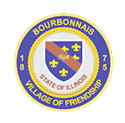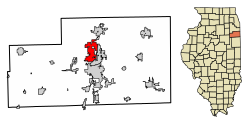Bourbonnais, Illinois
Bourbonnais | |
|---|---|
| Village of Bourbonnais | |
 Seal | |
| Motto(s): "Village of Friendship" | |
 Location of Bourbonnais in Illinois | |
 Location of Illinois in the United States | |
| Coordinates: 41°09′54″N 87°52′43″W / 41.16504°N 87.878486°WCoordinates: 41°09′54″N 87°52′43″W / 41.16504°N 87.878486°W | |
| Country | United States |
| State | Illinois |
| County | Kankakee |
| Named for | François Bourbonnais |
| Government | |
| • Mayor | Paul Schore (Bourbonnais Citizens Party) |
| Area | |
| • Total | 9.32 sq mi (24.13 km2) |
| • Land | 9.32 sq mi (24.13 km2) |
| • Water | 0.00 sq mi (0.00 km2) |
| Elevation | 660 ft (200 m) |
| Population (2010) | |
| • Total | 18,631 |
| • Estimate (2019)[3] | 19,462 |
| • Density | 2,088.65/sq mi (806.46/km2) |
| Time zone | UTC-6 (CST) |
| • Summer (DST) | UTC-5 (CDT) |
| Zip code | 60914 |
| Area code(s) | 815 and 779 |
| FIPS code | 17-07471 |
| Website | villageofbourbonnais.com |
Bourbonnais (/ˌbʊərboʊˈneɪ, bɜːrˈboʊnɪs/ BOOR-boh-NAY, bur-BOH-niss[4]) is a village in Kankakee County, Illinois, United States. The population was 18,631 in the 2010 census, but had grown to 19,462 in the 2019 census estimate.[5] It is part of the Kankakee-Bourbonnais-Bradley Metropolitan Statistical Area.
History[]
The village is named for François Bourbonnais, Sr., a fur trapper, hunter and agent of the American Fur Company, who had married a Native American woman and arrived in the area near the fork of two major Indian trails and the Kankakee River circa 1830.[6] John Jacob Astor had founded the company in 1808, and when the United States banned foreign (i.e. British and Canadian) companies (such as the Hudson's Bay Company) from competing in the country after the War of 1812, it flourished. By 1830 it had a near monopoly of fur trading in the midwest, but the number of local trappable wild animals had declined.
In 1832, Noel Le Vasseur arrived as the Astor firm local fur trading agent, establishing a trading post in the area, and becoming the first permanent non-Native American settler. He married Watseka, niece of a Potawatomi chieftain, and after the Potawatomi were relocated to Iowa, recruited French-Canadiens to settle around his store.[7] The Potawatomi were forced to move westward by a series of treaties culminating in the Treaty of Tippecanoe, which Congress ratified in 1833. The treaty reserved two sections for Potawanomi chief Me-she-ke-te-no, and one section each for Catish (Mrs. Bourbonnais, Sr.) and Manteno (daughter of Francois Bourbonnais, Jr.).[6] LeVasseur received considerable land through a series of shrewd trades, and eventually divorced Watseka and married a Canadian woman named Ruth.[8] After establishment of the new Catholic diocese of Chicago, missionary Fr. Stephen Badin briefly settled in Bourbonnais Grove in 1846, before retiring further south.

In 1853, the Illinois legislature split Iroquois County, and Bourbonnais Grove became part of new Kankakee County. Because the Illinois Central Railroad ran through Kankakee, founded in 1854, it became the county seat, with Bourbonnais Grove as one of several townships. In 1858 residents built the Maternity of the Blessed Virgin Mary Church, and soon nuns of the Congregation of Notre Dame arrived from Canada to teach and provide nursing care. Two years later they founded Notre Dame Academy. In 1865 clerics of St. Viator founded St. Viator College for boys.[9]
After a referendum in 1875, the settlement incorporated as the Village of Bourbonnais, with George R. LeTourneau as its first mayor, and trustees Francois Sequin, Joseph Legris, Alexis Gosselin, P.L. Monast, Alex LaMontagne, Joseph Goulet, Jacob Thyfault and Len Bessette. LeVasseur died, aged 80, four years later.[8] LeTourneau also became mayor and sheriff of Kankakee as well as state senator; his home (begun in 1837 and with renovations completed in 1866) eventually became headquarters of the local historical society, which is also restoring the garden and nearby arboretum.[10][11] After enrollment declines in the early 20th century, in 1940, the Catholic institutions were bought out by what became Olivet Nazarene University, since the Protestant school in nearby Vermillion County had burned down the previous year.
In 1999, the town was the site of a major train wreck, the Bourbonnais train accident.
Borbounnais was home of the summertime training camp of the Chicago Bears professional football team from 2002 to 2019. In 2020, the team relocated training camp to their headquarters at Halas Hall in Lake Forest, Illinois after major renovations of the building complex.[12]
Geography[]
According to the 2010 census, Bourbonnais has a total area of 9.31 square miles (24.11 km2), all land.[13]
Pronunciation[]
The original French pronunciation of Bourbonnais came to be Anglicized over time to /bərˈboʊnɪs/ bər-BOH-nis. In 1974, a state representative from Bourbonnais introduced a resolution "correcting" the pronunciation of the town's name to /bɜːrbəˈneɪ/ bur-bə-NAY, closer to the French.[14]
Demographics[]
| Historical population | |||
|---|---|---|---|
| Census | Pop. | %± | |
| 1900 | 595 | — | |
| 1910 | 611 | 2.7% | |
| 1920 | 620 | 1.5% | |
| 1930 | 685 | 10.5% | |
| 1940 | 771 | 12.6% | |
| 1950 | 1,598 | 107.3% | |
| 1960 | 3,336 | 108.8% | |
| 1970 | 5,909 | 77.1% | |
| 1980 | 13,280 | 124.7% | |
| 1990 | 13,934 | 4.9% | |
| 2000 | 15,256 | 9.5% | |
| 2010 | 18,631 | 22.1% | |
| 2019 (est.) | 19,462 | [3] | 4.5% |
| US Decennial Census[15] | |||
As of the 2000 United States Census,[16] there were 15,256 people, 5,341 households, and 3,818 families in the village. The population density was 3,302.1/sqmi (1,275.0/km2). There were 5,505 housing units at an average density of 1,191.5/sqmi (460.1/km2). The racial makeup of the village was 90.21% White, 4.59% African American, 0.10% Native American, 2.39% Asian, 0.03% Pacific Islander, 0.69% from other races, and 1.48% from two or more races. Hispanic or Latino of any race were 2.26% of the population.
There were 5,341 households, out of which 37.9% had children under the age of 18 living with them, 57.1% were married couples living together, 11.2% had a female householder with no husband present, and 28.5% were non-families. 22.6% of all households were made up of individuals, and 7.0% had someone living alone who was 65 years of age or older. The average household size was 2.58 and the average family size was 3.07.
The village population contained 25.5% under the age of 18, 15.5% from 18 to 24, 27.9% from 25 to 44, 21.8% from 45 to 64, and 9.3% who were 65 years of age or older. The median age was 32 years. For every 100 females, there were 90.8 males. For every 100 females age 18 and over, there were 86.2 males.
The median income for a household in the village was $49,329, and the median income for a family was $57,086. Males had a median income of $42,216 versus $26,796 for females. The per capita income for the village was $22,476. About 5.2% of families and 6.5% of the population were below the poverty line, including 7.1% of those under age 18 and 3.0% of those age 65 or over.
Education[]
Bourbonnais shares a high school, Bradley-Bourbonnais Community High School (BBCHS), with Bradley, Illinois. The high school's mascot is the "Boilermaker". The Kankakee Area Career Center (KACC) serves local area high school students as a vocational and technical education institution. Bourbonnais is served by three private high schools: Bishop McNamara Catholic School (Catholic), Grace Christian Academy[17] (non-denominational[18]), and (inter-denominational [19]).The village is home to Olivet Nazarene University (ONU), on the site of the old St. Viator College campus.
Chicago Bears training camp[]
The Chicago Bears of the National Football League held their annual summer training camp at Olivet Nazarene University in Bourbonnais from 2002 through 2019.[20]
Shopping[]
The town's main shopping mall is Northfield Square. Many new stores have been built and introduced, however, in the following years just down the road from the mall.
References[]
- ^ "Government webpage". Village of Bourbonnais. Retrieved 7 July 2017.
- ^ "2019 U.S. Gazetteer Files". United States Census Bureau. Retrieved July 14, 2020.
- ^ Jump up to: a b "Population and Housing Unit Estimates". United States Census Bureau. May 24, 2020. Retrieved May 27, 2020.
- ^ "Define Bourbonnais at Dictionary.com". Retrieved May 18, 2015.
- ^ "Population and Housing Unit Estimates". Retrieved May 21, 2020.
- ^ Jump up to: a b "History". Village of Bourbonnais. Archived from the original on 30 October 2012. Retrieved 29 September 2013.
- ^ "Local History". Bourbonnais Grove Historical Society.
- ^ Jump up to: a b Noel LeVasseur in Bourbonnais Illinois.wmv - via YouTube
- ^ "A Brief History". Viatorians.
- ^ "Letourneau Museum". Archived from the original on January 14, 2012.
- ^ "Bourbonnais". Antiquing Illinois. Archived from the original on August 17, 2014.
- ^ "Bears moving training camp to Halas Hall". Pro Football Talk. January 14, 2020. Retrieved October 2, 2020.
- ^ "Geographic Identifiers - 2010 Census Summary File 1". US Census Bureau. Archived from the original on 13 February 2020. Retrieved 2 August 2015.
- ^ Mike Ramsey (January 10, 2006). "Legislator's name mentioned in Ryan trial, but in good way". SJ-R.COM. Archived from the original on 17 March 2006.
- ^ "Census of Population and Housing". US Census Bureau. Retrieved June 4, 2015.
- ^ "U.S. Census website". US Census Bureau. Retrieved 31 January 2008.
- ^ Leonhardt, Nicole. "Kankakee: Name change introduces Grace Christian Academy". The Daily Journal. Retrieved 2021-07-16.
- ^ "Grace Baptist Academy". gracecrusaders.org. Grace Baptist Academy. Archived from the original on March 9, 2012. Retrieved June 8, 2012.
- ^ "Our Purpose". Kankakee Trinity Academy. Archived from the original on May 16, 2012. Retrieved June 8, 2012.
- ^ https://www.chicagobears.com/news/bears-moving-training-camp-back-to-halas-hall
External links[]
- Villages in Kankakee County, Illinois
- Villages in Illinois
- Populated places established in 1830
- 1830 establishments in Illinois



